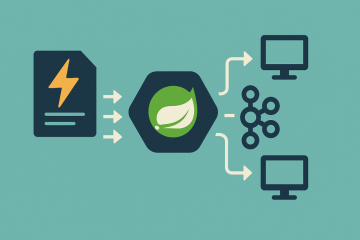Deploying a Spring Boot application on AWS requires choosing the right compute service that balances scalability, performance, and cost-efficiency. Two popular AWS options for running Spring Boot applications are AWS Elastic Container Service (ECS) and AWS Lambda. This guide explores their differences, best use cases, and how to deploy a Spring Boot application on both.
1. Understanding ECS and Lambda
AWS Elastic Container Service (ECS)
AWS ECS is a container orchestration service that allows you to deploy, manage, and scale containerized applications using Docker.
- Supports custom environments with control over the OS, dependencies, and configurations.
- Can run on EC2 (self-managed infrastructure) or Fargate (serverless compute).
- Ideal for long-running applications and microservices architectures.
Example Use Case: Deploying a Spring Boot REST API as a Docker container that handles high-traffic workloads.
AWS Lambda (Serverless Compute)
AWS Lambda allows running code without provisioning or managing servers. It executes code only when triggered and scales automatically.
- No infrastructure management, runs fully serverless.
- Auto-scales based on incoming requests.
- Best suited for event-driven applications with short-lived execution.
Example Use Case: A Spring Boot API that performs lightweight tasks such as processing form submissions or triggering database updates.
2. Key Differences Between ECS and Lambda
| Feature | AWS ECS | AWS Lambda |
|---|---|---|
| Compute Model | Container-based | Serverless, function-based |
| Scalability | Auto-scales with ECS Service Auto Scaling | Auto-scales per request |
| Pricing Model | Pay for instance/container usage | Pay per execution time |
| Startup Time | Always running or cold starts in Fargate | Cold starts (~100ms) for inactive functions |
| Use Case | Long-running apps, microservices | Event-driven tasks, API backends |
3. Deploying a Spring Boot Application on AWS ECS
Step 1: Containerizing the Spring Boot App
# Dockerfile
FROM openjdk:17-jdk-slim
VOLUME /tmp
COPY target/myapp.jar app.jar
ENTRYPOINT ["java", "-jar", "app.jar"]Step 2: Push the Image to Amazon Elastic Container Registry (ECR)
aws ecr create-repository --repository-name spring-boot-app
aws ecr get-login-password --region us-east-1 | docker login --username AWS --password-stdin <your-ecr-url>
docker build -t spring-boot-app .
docker tag spring-boot-app:latest <your-ecr-url>/spring-boot-app:latest
docker push <your-ecr-url>/spring-boot-app:latestStep 3: Deploying the Container on ECS (Fargate Mode)
aws ecs create-cluster --cluster-name springboot-cluster
aws ecs create-task-definition --family springboot-task \
--network-mode awsvpc --requires-compatibilities FARGATE \
--cpu 512 --memory 1024 --container-definitions '[{"name":"spring-boot-container","image":"<your-ecr-url>/spring-boot-app:latest","portMappings":[{"containerPort":8080,"hostPort":8080}]}]'Step 4: Running the Service
aws ecs create-service --cluster springboot-cluster --service-name springboot-service \
--task-definition springboot-task --desired-count 1 --launch-type FARGATE \
--network-configuration 'awsvpcConfiguration={subnets=[subnet-abc123],securityGroups=[sg-xyz123],assignPublicIp="ENABLED"}'4. Deploying a Spring Boot Application on AWS Lambda
Step 1: Convert Spring Boot to a Serverless Function
Use AWS Lambda Adapter or Spring Cloud Function to run Spring Boot as a function.
@SpringBootApplication
public class LambdaApplication implements RequestHandler<Map<String, Object>, String> {
@Override
public String handleRequest(Map<String, Object> input, Context context) {
return "Hello from AWS Lambda!";
}
}Step 2: Build and Package the Application
mvn clean package
zip -j target/lambda.zip target/myapp.jarStep 3: Deploy to AWS Lambda
aws lambda create-function --function-name SpringBootLambda \
--runtime java17 --role <iam-role-arn> \
--handler LambdaApplication::handleRequest --zip-file fileb://target/lambda.zip5. Choosing Between ECS and Lambda for Spring Boot
Use ECS When:
- The application requires long-running processes.
- You need full control over networking, dependencies, and configuration.
- The application handles high traffic and needs persistent connections.
- You require integration with databases like RDS or DynamoDB.
Use Lambda When:
- The application is event-driven (e.g., API Gateway, S3, DynamoDB events).
- You need auto-scaling without server management.
- The application has low execution time and doesn’t require persistent state.
- You are optimizing for cost efficiency with a pay-per-execution model.
Conclusion
AWS ECS and Lambda offer different deployment strategies for Spring Boot applications. ECS is ideal for long-running, scalable applications, while Lambda is best suited for lightweight, event-driven workloads. Choosing the right solution depends on the application’s requirements, scalability needs, and cost considerations.



0 Comments